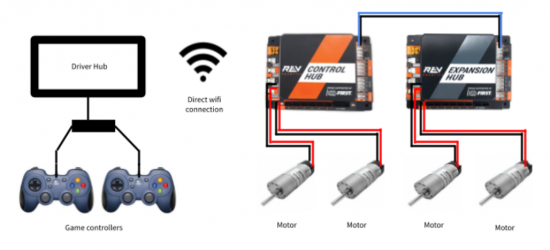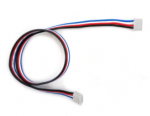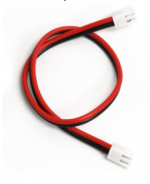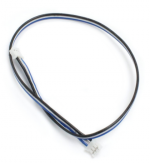FTC:Electronics
Electronics are what allows the robot to function properly. These different electronic parts are the main components used in the electronics of a robot in FIRST Tech Challenge.
Driver Hub and Control Hub Interaction
This diagram shows the basic layout for a robot’s electronics. First, the drivers input commands into the game controllers that are programmed for specific tasks on the robot. The inputs then go to the Driver Hub. The Driver Hub then transmits commands to the Control Hub via Wifi Direct. The Control Hub in turn sends commands to the motors and sensors. It also connects directly with the Expansion Hub via the blue transmission wire. The Expansion Hub is used to add additional motors and sensors.
REV Driver Hub
The Driver Hub is an Android device and has a touch screen and multiple ports for the game controllers.
REV Control Hub
The Control Hub is an Android device and has ports for 4 DC motors, 6 servos and 16 sensors. It is the main controller of the robot, controlling even the Expansion Hub.
REV Expansion Hub
The Expansion Hub is used if you need more than for DC motors on your robot. It is also nice to have on your robot on the side opposite the control hub to allow for shorter wire spans for electronics connections.
DC Motors
There are many different types of motors that can be used for driving or various subsystems. Choose an appropriate motor for the task it should complete. The list below is a partial list of DC Motors that are legal to use in FTC. Evaluate these motors to determine which will be the best for your subsystem.
Common Motor Examples
| Name | Pros | Cons | Uses |
| NeveRest Orbital 20 Gearmotor |
|
|
Good for use in high speed subsystems such as launchers |
| NeveRest 40 |
|
|
Good for use in driving |
| NeveRest 60 |
|
|
Good for high torque subsystems |
| TETRIX MAX DC Motor |
|
|
This motor is outperformed by many other motors. |
| REV Ultra Planetary Gearmotor |
|
|
High speed subsystems and driving |
| REV HD Hex Motor 20:1 Planetary |
|
|
High speed subsystems and driving |
| REV HD Hex Motor 40:1 |
|
|
Good for driving and for high torque subsystems |
| REV Core Hex Motor |
|
|
Good for low speed subsystems |
| TETRIX Torquenado |
|
|
Great for heavy subsystems or lifting heavy things. |
| goBilda 5202 Series Yellow Jacket Planetary Gear Motor |
|
|
Good for subsystems and driving. It can be put into a goBilda U-channel. |
| goBilda 5203 Series Yellow Jacket Planetary Gear Motor |
|
|
Good for subsystems and driving. It can be put into a goBilda U-channel. |
Servos
In FTC, servos are used in many different subsystems for moving or lifting smaller parts because they aren’t as strong as normal motors. They are also typically more precise than motors. However, most servos only rotate 180 degrees. Continuous servos do not have that rotation restriction. Servos go well with custom parts to perform multiple functions. Below is a partial list of legal servos. Do some research to find the best servo for your subsystem.
| Name | Function |
| REV Smart Robot Servo | The REV Smart Servo is able to be programmed to be both continuous and angular. Continuous allows for the servo to act like a motor. Angular Mode allows the servo to move to set positions. |
| VEX EDR 393 | The VEX EDR 393, although called a motor, counts as a servo in FTC. To use it teams need to connect it to a REV Servo Power Module. The EDR has a higher stall torque than most servos, so it can be used to manipulate heavier objects. |
| GoBuilda 2000 Series Dual Mode Servo | There are two versions of this servo, speed and torque. The speed version moves twice as fast as the torque version, while the torque version has twice the stall torque. Both types are able to be programmed to positions. |
| 20KG Digital Servo | The 20KG servo has incredibly high torque for a servo. It is an angular servo, meaning that it is able to be programmed to go to set positions. |
| TETRIX® MAX Standard-Scale Servo Motor | The Tetrix MAX Servo is able to turn 180 degrees. It is weaker than the other servos and isn’t able to move as fast. |
REV Smart Robot Servo Programming
The REV Smart Robot Servo is a programmable servo that allows for many different applications. Teams are able to program it to be in either a continuous or angular mode. To program it, teams need to use the REV SRS Programmer. Here is a video guide that teams can use to learn how to use the SRS Programmer.
Sensors
There are many different sensors that an FTC team can use.
| Name | Function |
| Gyro/IMU | Measures how many degrees your robot is turning, which allows for better turning in autonomous.The IMU is an internal gyro sensor built into the REV Control and Expansion Hubs. |
| Vision | Webcams are a great way to detect many things on the field. This could be used to make the robot move to an object, aim for certain positions, and much more. |
| Touch | A touch sensor is a button that when pressed, will tell the robot to implement a certain command. |
| Light | Detects various amounts of light that will be present in certain areas of the field. The robot then can perform a task based on the light level. |
| Distance | Determines how far something is from the robot so it knows not to run into it, or how close it can get to it. |
Wires
| Name | Function |
| Power | Provide power from the battery to the REV hubs. The REV hubs then distribute it to the other electronics |
| Encoder | Accurately controls the motors to make the robot have better movement and turning. |
| Motor/Servo Wires | Provide power and control to motors and servos. |
| JST PH 3-pin Communication Cable | Connects together REV hubs like the Control and Expansion Hub. |
Additional Resources
- NeveRest Orbital 20 Gearmotor
- NeveRest 40
- NeveRest 60
- TETRIX MAX DC Motor
- REV Ultra Planetary Gearmotor
- REV HD Hex Motor 20:1 Planetary
- REV HD Hex Motor 40:1
- REV Core Hex Motor
- TETRIX Torquenado
- REV Smart Robot Servo
- VEX EDR 393
- GoBuilda 2000 Series Dual Mode Servo
- 20KG Digital Servo
- TETRIX® MAX Standard-Scale Servo Motor
- goBilda 5202/5203 Series Yellow Jacket Planetary Gear Motor
- How Do You Program Servos Video Guide





